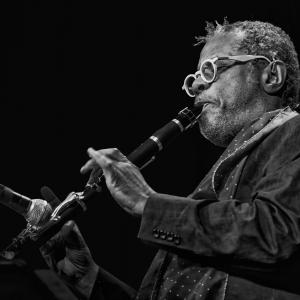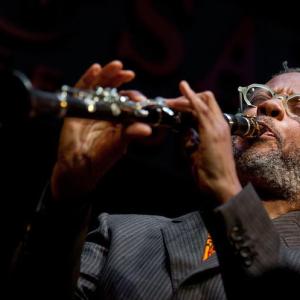NEC Jazz Orchestra + Ken Schaphorst: Crossing the Boundaries with Special Guest Don Byron '84
Celebrating the 50th anniversary of the Contemporary Musical Arts department (formerly Contemporary Improvisation), Ken Schaphorst directs the NEC Jazz Orchestra with special guest clarinetist and NEC alumnus Don Byron '84. Crossing the Boundaries highlights music inspired by diverse global and improvisational traditions and includes a tribute to pioneering musical theorist, composer and NEC guru George Russell (1923- 2009). The program also includes arrangements and compositions by Randy Weston/Melba Liston, Duke Ellington, Sam Rivers, Gerald Levinson, Ran Blake and others. Byron will be featured in an improvisation as well as pieces by Russell and Morton Gould. The concert is part of Byron’s residency which included an artist talk on December 6 and a master class on December 7 as well as rehearsals with the students.
This is an in-person event with a private stream available to the NEC community here: https://necmusic.edu/live.
- Don Byron '84, clarinet
- Ran Blake, piano
George Russell | Cubano Be Cubano Bop
Duke Ellington | Madness in Great Ones
Sam Rivers | Beatrice
Gerald Levinson | Bird Rock
Ran Blake (arr. Ken Schaphorst) | The Short Life of Barbara Monk
Artists- Ran Blake, piano
Randy Weston arr. Melba Liston | Little Niles
Randy Weston arr. Melba Liston | Bantu
INTERMISSION
Don Byron '84 | Improvisation
Artists- Don Byron '84, clarinet
George Russell | A Bird in Igor’s Yard
Don Byron '84 (arr. Ken Schaphorst) | Himm
Morton Gould | Derivations
Warm-Up
Contrapuntal Blues
Rag
Ride OutBiographies
The artistry of clarinetist Don Byron spans a range of musical styles. His early successes focused on his work playing Klezmer and the music of the late Mickey Katz. He subsequently earned fame for his exceptional contributions to jazz clarinet. His more than a dozen albums include Tuskegee Experiments, Nu Blaxpoitation, Don Byron Plays the Music of Mickey Katz and Bug Music. Byron’s composition, There Goes the Neighborhood, was commissioned by the Kronos Quartet and premiered in London in 1994. He has also written music for silent film and television and served as the director for the Brooklyn Academy of Music. At NEC, Byron studied with George Russell and was recruited to play in Hankus Netsky’s Klezmer Conservatory Band. He moved back to his native New York City in the mid-80s, where he played with artists including David Murray, Craig Harris and Hamiet Bluiett. In addition to his own discography, he has recorded with Bill Frisell, Joe Henry, Marc Ribot, Vernon Reid and Allen Toussaint. Byron’s honors include the Rome Prize, finalist for the Pulitzer Prize, a Guggenheim Fellowship and a Grammy nomination.
In a career that spans nearly six decades, pianist Ran Blake has created a unique niche as a composer, performing artist, and educator. With a characteristic mix of spontaneous solos, modern classical tonalities, the great American blues and gospel traditions, and themes from classic Film Noir, Ran’s singular sound has earned a dedicated following all over the world. His dual musical legacy includes nearly 50 albums on some of the world’s finest jazz labels, as well nearly five decades as a groundbreaking educator at New England Conservatory.
Blake discovered the dark, image-laden and complex character-driven films that would so influence his music when he first saw Robert Siodmak’s The Spiral Staircase at age 11. “There were post-World War II musical nuances that, if occasionally banal and as clichéd as yesterday’s soap operas, were often so eerie, haunting and unforgettable,” Ran would later write. After repeated viewings over three weeks, he recalls how “plots, scenes, and melodic and harmonic surfaces intermingled, obtruding into my daily life as well as my dreams.”
Long before the invention of virtual reality, Blake began mentally placing himself inside the films and real-life scenarios that inspired his original compositions like Spiral Staircase, Memphis and The Short Life of Barbara Monk. The influence of the Pentecostal church music he discovered as a teenager growing up in Suffield, Connecticut, combined with his musical immersion in what he terms “a Film Noir world,” laid the groundwork for his earliest musical style.
That early style would evolve when he and fellow Bard College student and vocalist Jeanne Lee became a duo in the late 1950s. Their partnership led to the landmark cult favorite The Newest Sound Around (RCA) in 1962, introducing the world to their unique talents and their revolutionary approach to jazz standards. This debut recording would also show the advancing synthesis of Ran’s diverse influences with its haunting version of David Raksin’s title track from the movie Laura and his original tribute to his first experience with gospel music, The Church on Russell Street.
The Newest Sound Around was encouraged and informally supervised by the man who would become Ran’s most significant mentor and champion, Gunther Schuller. The two began their forty-year friendship at a chance meeting at Atlantic Records’ New York studio in January 1959. Less than two years earlier, Schuller had coined the term “Third Stream” at a lecture at Brandeis University. Schuller was recording on Atlantic Records with future jazz legends John Lewis, Bill Evans, Eric Dolphy, and Ornette Coleman. Ran accepted what he calls “a low-level position” at Atlantic that allowed him to be close to inspirations like Chris Connor, Ray Charles, and Harlem’s famous Apollo Theater.
Schuller immediately saw the potential of Ran Blake’s unorthodox but unique musical style, and invited him to study at the Lenox School of Jazz in the summers of 1959 and 1960. While in Lenox, home also to Tanglewood, the classical music mecca in western Massachusetts, Ran studied with the jazz giants who formed the faculty of this one-of-a-kind institution—Lewis, Oscar Peterson, Bill Russo, and many others—and began formulating his style in earnest. He also studied in New York with piano legends Mary Lou Williams and Mal Waldron; other teachers included Bill Russo, Bill Evans, John Lewis, Max Roach, Oscar Peterson, and Stan Kenton. During those years he became close to Thelonious Monk and his family, and according to Nellie Monk, was the most trusted babysitter for their children. Monk remains Ran’s favorite pianist.
A year after Schuller became President of Boston’s New England Conservatory in 1967, he created the first department in the U.S. to offer a degree in jazz studies. Ran was invited to join other remarkable artists on the faculty Schuller was assembling, including George Russell, Carl Atkins, Jaki Byard, Jimmy Giuffre, and others. In 1973, Ran became the first chair of the Third Stream Department, which he co-founded with Schuller at the school. The department was recently renamed the Contemporary Improvisation Department, to acknowledge its evolution beyond Jazz and Classical to embrace the incredibly rich and varied World Music traditions.
Ran Blake’s teaching emphasizes what he calls “the primacy of the ear,” described at length in his 2010 book of the same title. His innovative approach elevates the listening process to the same status as the written score. This approach complements the stylistic synthesis of the original Third Stream concept, while also providing an open, broad based learning environment that promotes the development of innovation and individuality. Musicians of note who have studied with him at NEC include Dominique Eade, Don Byron, Matthew Shipp, Sara Serpa, and John Medeski.
While Ran Blake’s teaching career has been a major part of his musical legacy, his work as a composer and performer is the main source of his renown as a wholly individual artist—and the basis of his recognition as MacArthur “Genius” Fellow in 1988. Over the years he has performed in 48 of the 50 United States, throughout Europe and Scandinavia, collaborating and recording with such artists as George Russell, Steve Lacy, Rufus Reid, Jaki Byard, Anthony Braxton, Andrew Hill, Jimmy Giuffre, Houston Person, Ricky Ford, and Danilo Perez. His nearly 50 recordings have built a huge following around the world. Many of his most acclaimed recordings are tributes to artists like Monk, Sarah Vaughn, Horace Silver, George Gershwin, and Duke Ellington. Ran's most recent recordings are Ghost Tones: Portraits of George Russell (A-Side, 2015); Live at the Kitano w/Sara Serpa (Sunnyside, 2015); Down Here Below: A Tribute to Abbey Lincoln with Christine Correa (RedPiano, 2015); Chabrol Noir: A Tribute to Claude Chabrol with Ricky Ford (Impulse!, 2016); Town and Country with Dominique Eade (Sunnyside, 2017); Streaming with Christine Correa (RedPiano, 2018); and The Newest Sound You Never Heard: European Recordings 1966-67 (A-Side, 2019).
Ran Blake continues to evolve his noir language on the piano and remains as active as ever with full-time teaching, recordings, touring, and writing a new book, Storyboarding Noir: Ran Blake on Film. A recent Downbeat review said, “Ran Blake is so hip it hurts … a pianist who can make you laugh at his dry humor one second and wring a tear the next.” In the words of his fellow MacArthur Grant recipient and Kennedy Center Artistic Director for Jazz, Jason Moran: "It's this thunder-crack of sound that explodes from the instrument once he puts his hands on it. Ran's unlike anything else that exists. I hope musicians hear him and ask themselves, `Shouldn't we be taking more chances?' "Personnel
NEC Jazz Orchestra
Ken Schaphorst, conductor
Winds
Aaron Kaufman-Levine, alto saxophone, flute
Ben Eidson, alto and soprano saxophones
Chris Ferrari, tenor saxophone, clarinet
Sam Childs, tenor saxophone
Nick Biagini, baritone saxophone, bass clarinet
TrumpetsMark Tipton
Richard Stanmeyer
Lemuel Marc
Isaac Dubow
Trombones
Michael Gerace
Aiden Coleman
Dylan Rogan
Weza Jamison-Neto
Rhythm
Jonathan Paik, piano
Thatcher Harrison, guitar
Leo Weisskoff, bass
Alex Yoo, drums
Guests
Koki Renwick, trumpet
Kabir Adhiya-Kumar, Caleb Montague, Dominic Vance, percussion
Henry Wilson, vibraphone, xylophone


